

A Remarkably Brave P& O Officer Cadet
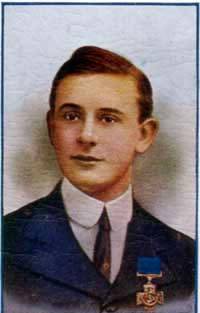
Midshipman George Leslie Drewry VC, Royal Naval Reserve, was born in 1894, at Forest Gate, London. He joined the Mercantile Marine after leaving Merchant Taylors School, Blackheath; early during his service he was shipwrecked, and spent 14 days on a desert island, living on edible roots and shell-fish. He joined the P. & O. as an officer cadet in 1912 and in the following year entered the Royal Naval Reserve. Called up for active service in August 1914, he was appointed Midshipman aboard H.M.S. Hussar. He was awarded the Victoria Cross - the first R.N.R./Merchant Navy award - for his outstanding gallantry in the famous landings from the S.S. River Clyde on the Gallipoli Peninsula on 25 April 1915.
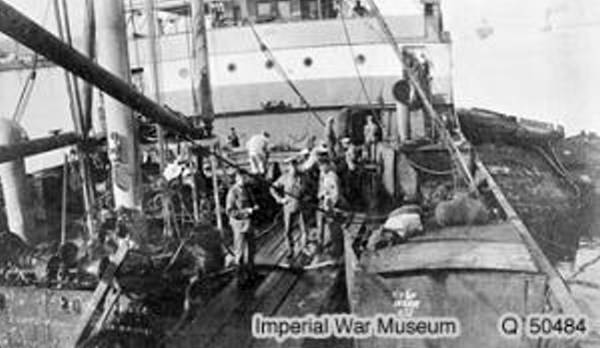
Machine guns and armour being fitted to the ss River Clyde for the landing at V Beach, Cape Helles.
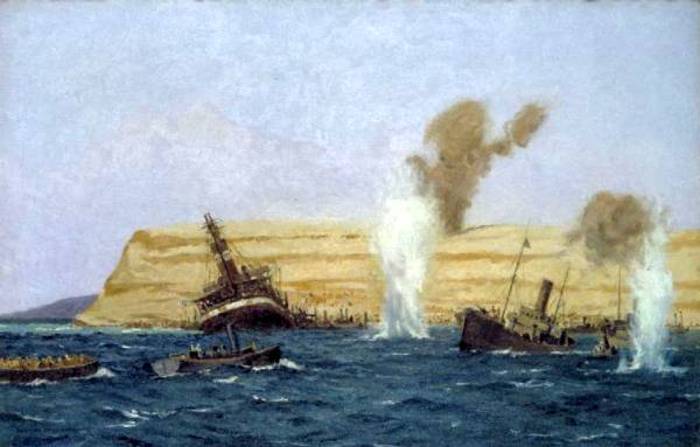
V Beach on the 25th April 1915, with the ss River Clyde aground and listing to port.
The Turkish defenders were ideally positioned to inflict massive casualties on the attacking infantry units.
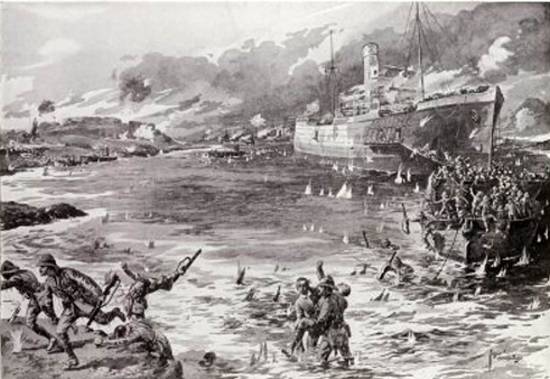
"At 6.10 a.m. on April 25th 1915, the River Clyde struck V Beach, and the hopper went ahead and grounded on the port bow, in the charge of Midshipman Drewry. In the midst of very dangerous firing from the opposite shore, Drewry jumped over the bow and waded towards the beach. Meeting a soldier wounded in the water, he tried to carry him ashore with the assistance of another soldier, but the man was shot in the arms of the rescuers. Drewry then ran along the bridge, but seeing Commander Unwin and Able seaman Williams towing the lighters he waded out and assisted them in securing the boats under heavy rifle and maxim fire. He was wounded in the head, but continued his work and twice subsequently attempted to swim from lighter to lighter with a line."
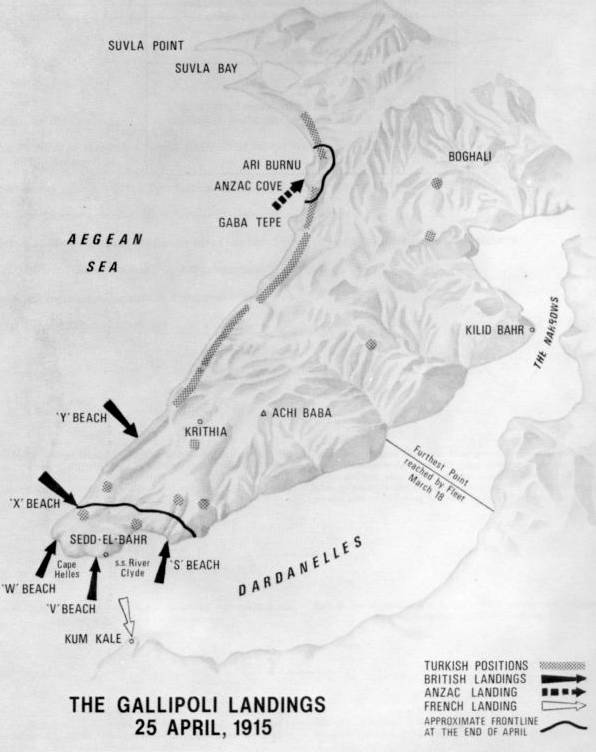
Vice-Admiral John de Robeck - commanding the fleet operations at Gallipoli -
despatch regarding the landing at "V" Beach.-
"This beach, it was anticipated, would be the most difficult to capture; it
possessed all the advantages for defence which "W" beach had, and in addition
the flanks were strongly guarded by the old castle and village of Seddul Bahr on
the east and perpendicular cliffs on the west; the whole foreshore was covered
with barbed wire entanglements which extended in places under the sea. The
position formed a natural amphitheatre with the beach as stage. The first
landing here, as at all other places, was made in boats, but the experiment was
tried of landing the remainder of the covering force by means of a collier, the
"River Clyde." This steamer had been specially prepared for the occasion under
the directions of Commander Edward Unwin; large ports had been cut in her sides
and gangways built whereby the troops could reach the lighters which were to
form a bridge on to the beach. "V" beach was subjected to a heavy bombardment
similarly to "W" beach, with the same result, i.e., when the first trip
attempted to land they were met with a murderous fire from rifle, mortar and
machine gun, which was not opened till the boats had cast off from the
steamboats. A landing on the flanks here was impossible and practically all the
first trip were either killed or wounded, a few managing to find some slight
shelter under a bank on the beach; in several boats all were either killed or
wounded; one boat entirely disappeared, and in another there were only two
survivors. Immediately after the boats had reached the beach the ''River Clyde''
was run ashore under a heavy fire rather towards the eastern end of the beach,
where she could form a convenient breakwater during future landing of stores,
&c. As the "River Clyde" grounded, the lighters which were to form the bridge to
the shore were run out ahead of the collier, but unfortunately they failed to
reach their proper stations and a gap was left between two lighters over which
it was impossible for men to cross; some attempted to land by lumping from the
lighter which was in position into the sea and wading ashore; this method proved
too costly, the lighter being soon heaped with dead and the disembarkation was
ordered to cease. The troops in the "River Clyde" were protected from rifle and
machine-gun fire and were in comparative safety. Commander Unwin, seeing how
things were going, left the " River Clyde " and, standing up to his waist in
water under a very heavy fire, got the lighters into position; he was assisted
in this work by Midshipman G. L. Drewry, RNR, of H.M.S. "Hussar"; Midshipman W.
St. A. Malleson, RN., of H.M.S. "Cornwallis" : Able Seaman W. C. Williams, O.N.
186774 (R.F.R. B.3766), and Seaman RNR George McKenzie Samson, O.N. 2408A, both
of H.M.S. "Hussar." The bridge to the shore, though now passable, could not be
used by the troops, anyone appearing on it being instantly shot down, and the
men in " River Clyde" remained in her till nightfall. At 9.50 a.m. "Albion" sent
in launch and pinnace manned by volunteer crews to assist in completing bridge,
which did not quite reach beach; these boats, however, could not be got into
position until dark owing to heavy fire. It had already been decided not to
continue to disembark on "V" Beach, and all other troops intended for this beach
were diverted to "W". The position remained unchanged on "V" beach throughout
the day, men of war and the maxims mounted in " River Clyde " doing their utmost
to keep down the fire directed on the men under partial shelter on the beach.
During this period many heroic deeds were performed in rescuing wounded men in
the water. During the night of the 25th-26th the troops in "River Clyde" were
able to disembark under cover of darkness and obtain some shelter on the beach
and in the village of Seddul Bahr, for possession of which now commenced a most
stubborn fight. The fight continued, supported ably by gunfire from H.M.S.
"Albion," until 1.24 p.m., when our troops had gained a position from which they
assaulted hill 141, which dominated the situation. " Albion" then ceased fire,
and the hill, with old fort on top, was most gallantly stormed by the troops,
led by Lieutenant-Colonel C. H. H. Doughty-Wylie, General Staff, who fell as the
position was won. The taking of this hill effectively cleared the enemy from the
neighbourhood of the "V" Beach, which could now be used for the disembarkation
of the allied armies. The capture of this beach called for a display of the
utmost gallantry and perseverance from the officers and men of both
services-that they successfully accomplished their task bordered on the
miraculous. Landing on the Camber, Seddul Bahr.- One half company Royal Dublin
Fusiliers landed here, without opposition, the Camber being " dead ground." The
advance from the Camber, however, was only possible on a narrow front, and after
several attempts to enter the village of Seddul Bahr this half company had to
withdraw after suffering heavy losses.
"At last we had the signal at 6 a.m. and in we dashed . At 6.10 the ship struck, very easily - she brought up and I shot ahead and grounded on her port bow. Then the fun began, picket boats towed lifeboats full of soldiers inshore and slipped them as the water shoaled and they rowed the rest of the way. The soldiers jumped out as the boats beached and they died almost all of them, wiped out with the boat's crews." Midshipman George Leslie Drewry VC, RNR
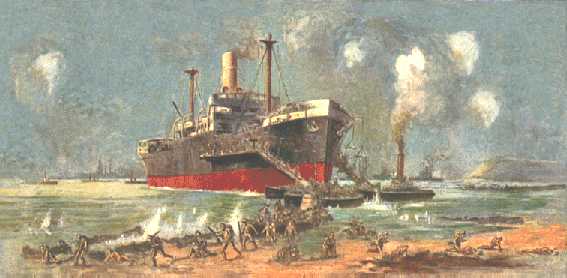
The 1st Battalion Royal Dublin Fusiliers, along with the Munster Fusiliers and the Royal Hampshire Regiment, landed at V Beach off a steam collier called the SS River Clyde. Sides had been cut out of the Clyde and the landing plan was for the Clyde to be beached and that the 2000 men inside her would run down wooden gangways onto pontoons that had been dragged near the shore alongside the ship.
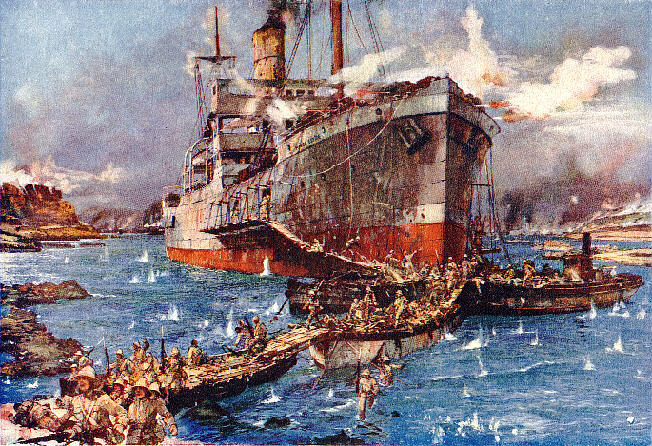
The SS River Clyde at V Beach by Charles Dixon
From the pontoons the men would jump onto the beach and advance inland to fight the Turks. Machine gun fire would cover the men coming ashore. But it all went wrong. The German commander advising with the Turks, General Von Sanders, knew that Cape Helles was a vitally important part of the peninsula, so he had heavily defended it with barbed wire under the water, and along the ridge he placed more wire and machine-gun placements. The Dubline Fusiliers, Munsters and Hampshires did not stand a chance as they were subjected to merciless enfilade fire.
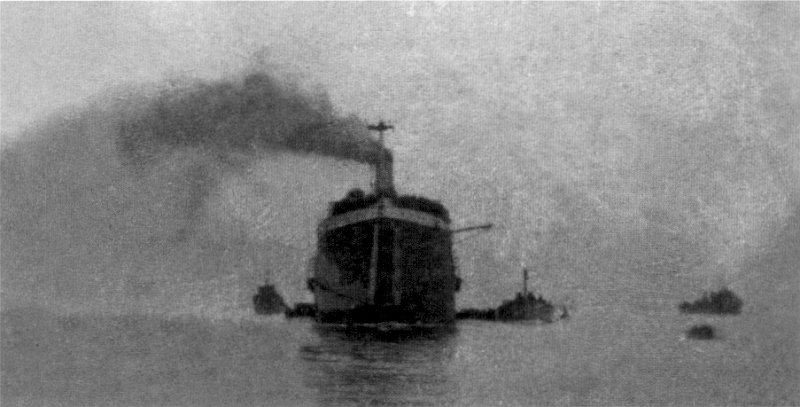
The ss River Clyde beached 80 yards out. The Turks machine guns opened up. Many men sank owing to the weight of their equipment and were drowned. The carnage on 'V' Beach was chilling; dead and wounded lay at the waters edge tinted crimson from their blood. Three attempts were made to get ashore by companies of the Munsters and The Hampshire Regiment but all ended in costly failure. Further attempts to land were abandoned and the surviving soldiers waited until nightfall before trying again. The efforts of sailors to maintain the bridge from the ship to the beach, and to recover the wounded, were rewarded by six Victoria Crosses. The recipients were Commander Unwin (aged 51), Midshipmen George Drewry RNR (20) and Wilfred Malleson (18), Able Seaman William Williams (34), Seaman George Samson (26) and Sub-Lieutenant Arthur Tisdall (24) from the Royal Naval Division (RND). Of these men, Williams died during the landing and Samson was severely wounded the following day. On his return to Scotland he was handed a white feather while wearing civilian clothes. Tisdall was killed on May 6 when the 6th (Hood) Battalion of the Royal Naval Division, made its advance along Kanli Dere during the Second Battle of Krithia. Malleson, who died in 1975, served in the battleship HMS Cornwallis.
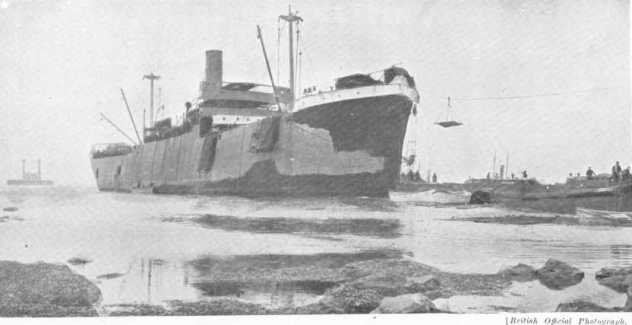
The ss River Clyde, British Official Photograph, taken some time after the landings on 25 April 1915.
The converted Collier, with over 2,000 troops on board grounded at V Beach, Cape Helles, at 6.10 a.m.; the lighters which were to form a bridge to the beach failed to position correctly, leaving a gap between them. Unable to cross, some men jumped into the sea and attempted to wade to the beach but many were cut down by the murderous rifle, pom-pom and machine-gun fire from the Turkish shore positions.
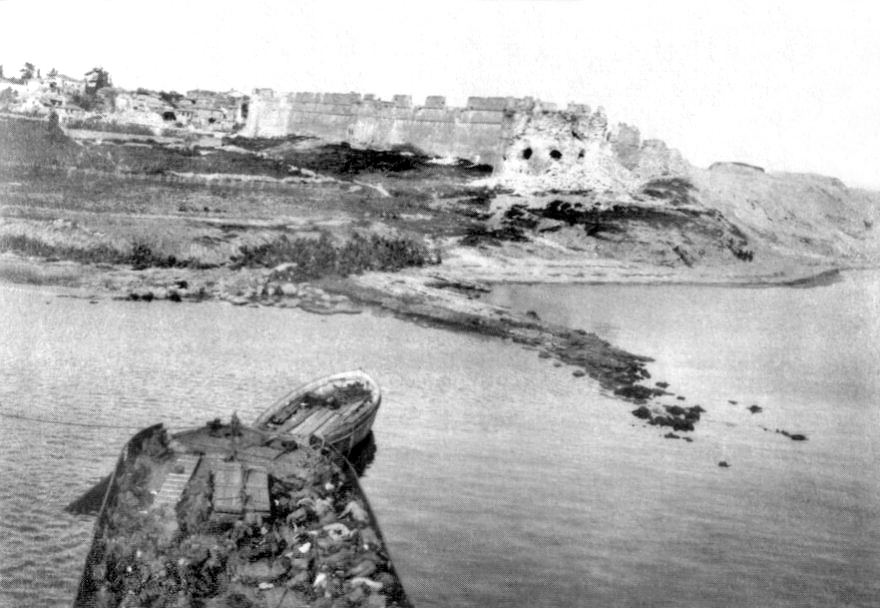
Sedd-el-Bahr fort and village seen from the SS River Clyde, 25 April 1915, during the landing at Cape Helles. The lighter in the foreground contains dead from the Royal Munster Fusiliers and The Hampshire Regiment, who were killed while attempting to get ashore.
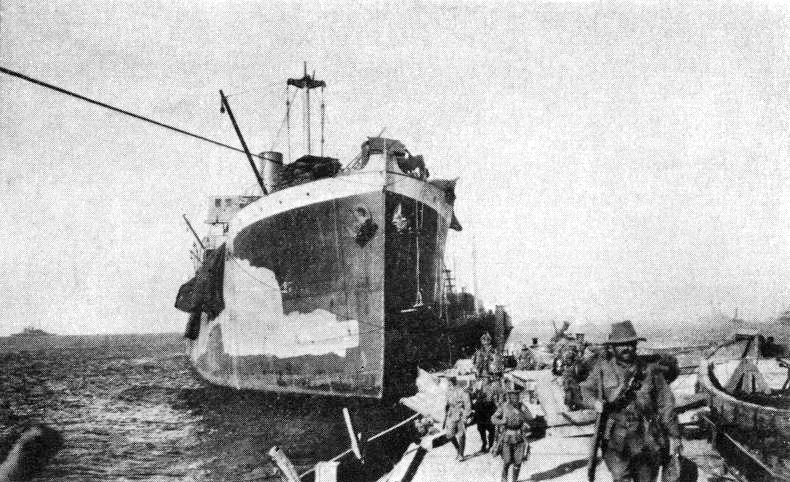
The Australian 2nd Infantry Brigade disembarking alongside the SS River Clyde at V Beach, Cape Helles on 6 May 1915, prior to their involvement in the Second Battle of Krithia. It was intended to paint the hull of the River Clyde yellow as camouflage but the photo shows the painting was incomplete before the landings of 25 April.
Those who reached the beach, struggled through masses of barbed wire and other obstacles. Midshipman Drewry assisted Commander Unwin and Seaman Williams in securing the boats in an attempt to bridge the gap. Although wounded in the head, Drewry continued his work and twice subsequently attempted to swim from lighter to lighter with a line. Five naval Victoria Crosses were awarded for this operation.
The River Clyde remained beached as a dock and breakwater. Her condensers were used to provide fresh water and a field dressing station was established in the hull. She remained a constant target for Turkish gunners until the end of the campaign.
From The London Gazette, 16th August 1915
Under the guidance of Commander Unwin, the SS River Clyde, an old collier, was prepared for landing thousands of troops on 'V' Beach, Seddul Bahr, Gallipoli. Large holes were cut in the ship's side level with the decks, and sloping gangways suspended by wire hawsers were run out so that the men could rush down them as soon as the ship touched the ground. Barges had been made fast to the sides of the steamer so that a floating bridge could be formed from them if the River Clyde grounded too far from the beach. Alongside were five 'tows' of five boats each, packed with men of the Dublin Fusiliers, who were to land first and cover the disembarkation of the troops. The open boats and River Clyde touched ground almost at the same moment and no sooner had the first of them grated on the bottom than a terrific fire was opened from the whole of the surrounding hills that dominated the beach. For a considerable distance to seaward the sea bed had been strewn with barbed wire and as the Dublin Fusiliers leapt into the water they found themselves entangled in the wire and were shot down where they stood. The open boats were held fast and their naval crews were wiped out. As the River Clyde grounded, the barges that were to form the bridge were run out ahead, and the troops began to pour out of the holes in her sides and down the gangways; but the barges failed to reach their proper stations. A gap was left between two of them which made it impossible for the men to cross, and scores were shot down as they stood helpless on the uncompleted bridge. Commander Unwin RN, the Beachmaster and Able Seaman Williams made a line fast to one of the drifting barges and, dropping over the side, waded through the water towing the barge towards a spit of rock that gave direct access to the shore. Midshipman Drewry, was already in the water wading ashore to secure the towing rope. In the meantime, Commander Unwin and Williams had nearly reached the rock with the barge in tow when they found the rope they had was not long enough. Drewry at once went back to the ship to get another length, and while the other two were waiting, Williams was shot as he stood breast-deep in the water. Unwin carried him back to the barge but Williams was already dead. When Drewry returned with the rope it did not take long to make the barge fast, and then the troops began at once to cross the bridge which remained under heavy fire. A shot then severed the lashing rope, and again the barges went adrift. Midshipman Drewry was aboard the inshore barge, and was struck in the head by a fragment of shell. He hastily bound his wound with a soldier's scarf, and, jumping overboard with a line between his teeth, swam towards the other barge. Once again the rope was too short but Midshipman Malleson threw himself over the side with a longer rope and lashed the barges together. The rope broke a third time, and although Malleson tried twice more to connect the barges he was unsuccessful.
From The Supplement to the London Gazette, 16 August 1915
Despatch of Vice Admiral John M. De Robeck
Midshipman Drewry assisted Commander Unwin at
the work of securing the barges under heavy rifle and maxim fire. He was wounded
in the head, but continued his work and twice subsequently attempted to swim
from barge to barge with a line.
The King has
been graciously pleased to approve of the grant of the Victoria Cross to
Midshipman George Leslie Drewry, RNR for the conspicuous acts of bravery
mentioned in the foregoing despatch."
IMPERIAL WAR MUSEUM, LONDON

The ss River Clyde is run aground and listing to port, by Norman Wilkinson.
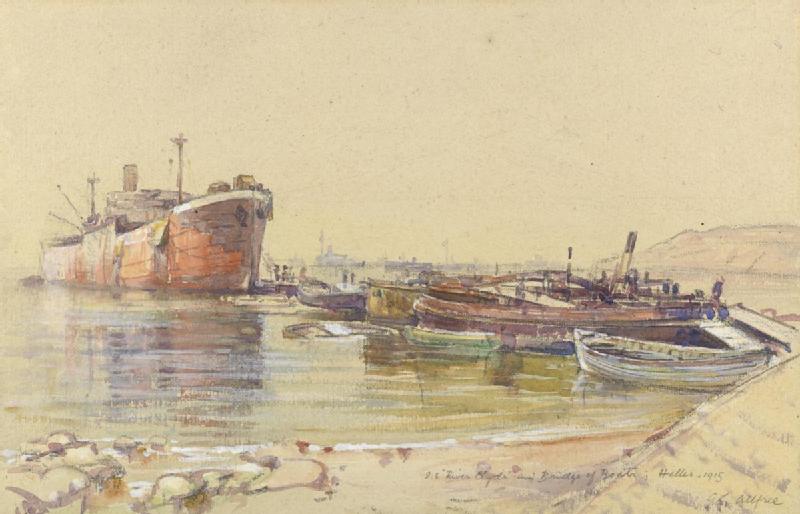
SS River Clyde run ashore with a gangway constructed from a bridge of boats stretching down onto the beach, by Geoffrey Stephen Alfree, 1915
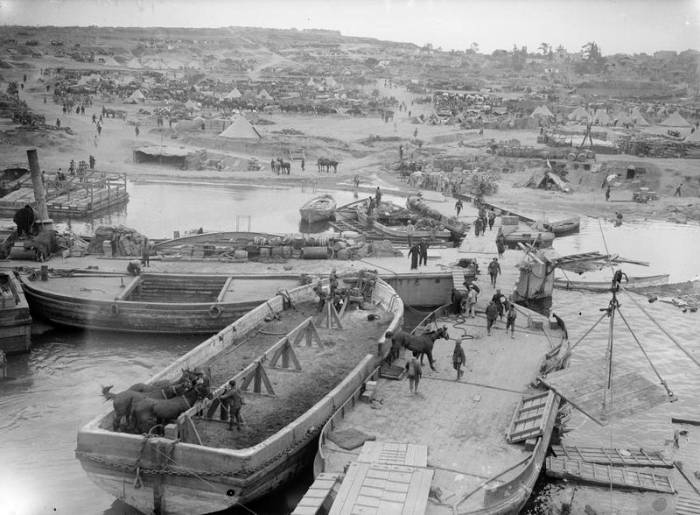
V Beach from the ss River Clyde
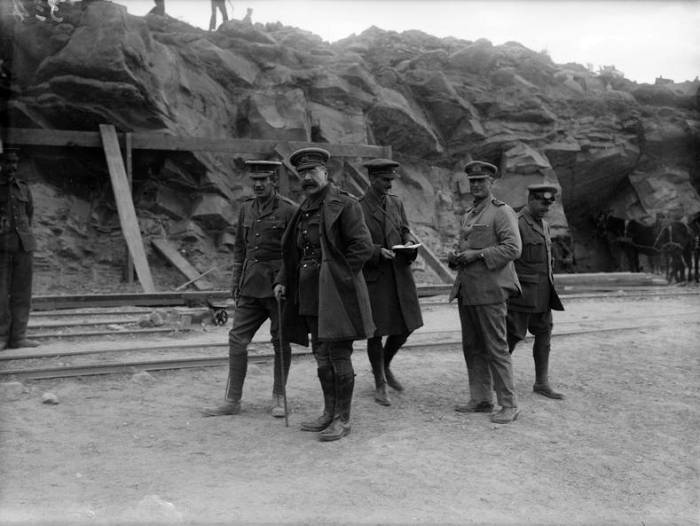
Major-General Altham, Inspector-General Line of Communications, (nearest camera) visiting Suvla with Commander Unwin, V. C., R. N., Beach Master at Suvla.
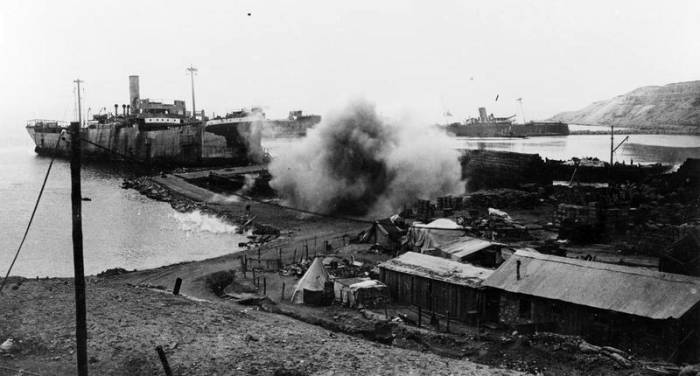
Turkish shells exploding near the ss River Clyde
Tragically, in 1918, Lieutenant Drewry VC, RNR, while in command of H.M.T. William Jackson, on the Northern Patrol, at Scapa Flow, Orkney Islands, was fatally injured on 2nd August, when a heavy block from the head of a derrick fell on his head. His skull was fractured and his left arm broken. He died the following day. His body was carried south and buried in the City of London Cemetery, Manor Park. His Victoria Cross is displayed at the Imperial War Museum. After the war a stained glass window was erected to his memory in All Saints Church, Forest Gate.
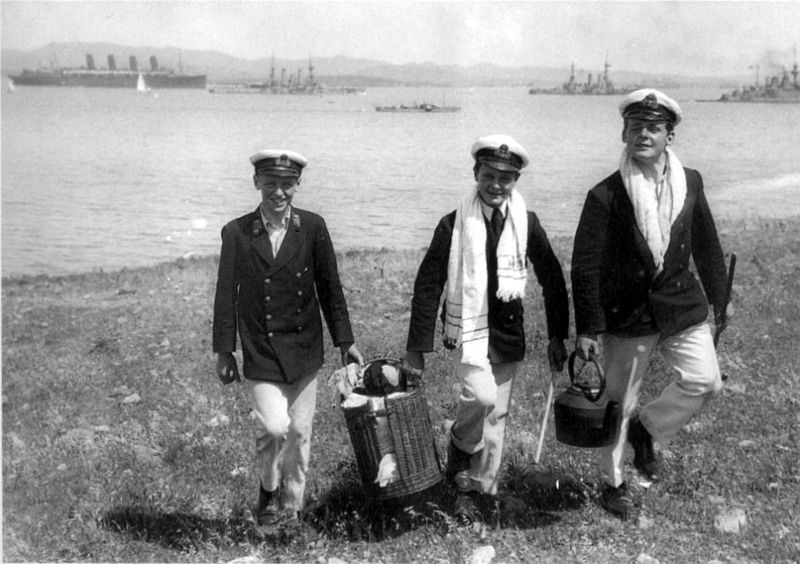
Three midshipmen, George Drewry, Wilfred Malleson and Greg Russell, having a picnic on Imbros during the Galipolli campaign.
Drewry and Malleson had just been awarded the Victoria Cross during the landing at V Beach, Cape Helles, on 25 April 1915.
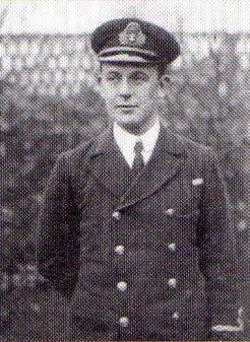
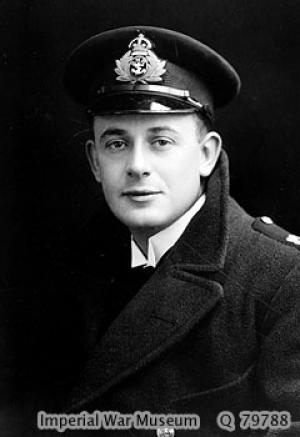
Promoted Acting Lieutenant RNR in November 1915, Drewry was appointed to the Orion Class battleship HMS Conqueror
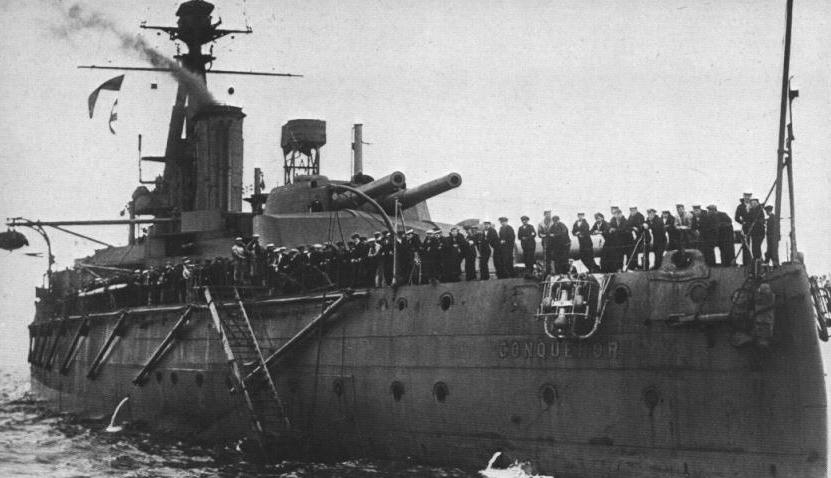
HMS Conqueror, viewed from off the port quarter.

Inscription: This sword of honour is presented by the Imperial Merchant Service Guild to their member
Midshipman (now Sub Lieutenant) George Leslie Drewry RNR the first officer of the Royal Naval Reserve
and the Merchant Service to win the Victoria Cross Dec 1st 1916.
Royal Navy officer's 'sword of honour' and scabbard as presented to Sub-Lieutenant George Leslie Drewry VC, RNR, on 1 December 1916, by the Imperial Merchant Service Guild in acknowledgment of him being the first Royal Naval Reserve Officer to win the Victoria Cross for his bravery as a Midshipman during the initial landings at Gallipoli, at 'V' Beach on 25 April 1915. (See The Supplement to the London Gazette, dated 16 August 1915, issue 29264, page 8132).
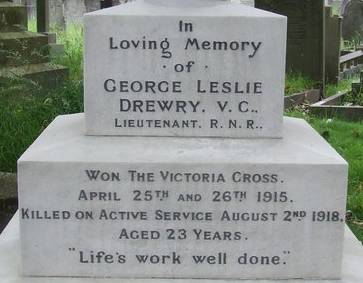
Monuments to Courage (David Harvey, 1999)
The Register of the Victoria Cross (This England, 1997)
Scotland's Forgotten Valour (Graham Ross, 1995)
VCs of the First World War - Gallipoli (Stephen Snelling, 1995)
VCs of the First World War - The Naval VCs (Stephen Snelling, 2002)